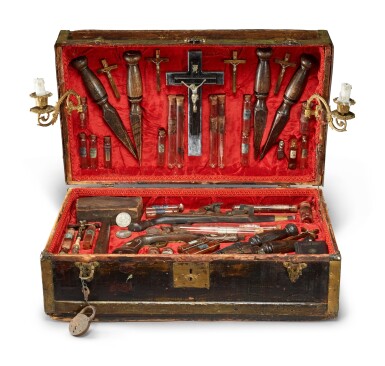
A Vampire Slaying Kit, 20th Century and Later
Lot Closed
April 21, 06:25 PM GMT
Estimate
3,000 - 5,000 USD
Lot Details
Description
A Vampire Slaying Kit, 20th Century and Later
comprising a variety of articles, including a velvet-lined wooden chest with a padlock and key, two removable gilt metal sconces, two replica pistols, a pocket Bible, a strand of rosary beads, six wooden stakes, seven crucifixes, one with a carved bone handle, one silvered pendant, and thirty-three glass vials. The vials bearing paper labels, most empty, one containing coyote teeth.
height 11 in.; width 26 in.; depth 15 ½ in.
27.9 cm; 66 in.; 39.4 cm
Originating from Eastern European folklore and disseminated throughout Europe when the Habsburg Empire invaded Serbia in 1718, the legend of vampires has captivated the cultural imagination for centuries. From the publication of Polidori’s “The Vampyre” in 1819 to Francis Ford Coppola’s Dracula film in 1992, the fascination with vampires has persisted to the present day as a continual source of inspiration for Hollywood.
There has been debate regarding the origin of vampire slaying kits. While some vampirists claim such kits were common in the eighteenth and nineteenth centuries, they were more likely assembled following the publication of Bram Stoker's novel Dracula in 1897 and marketed to travelers visiting eastern Europe. This unique and extensive kit contains a variety of curios, some associated, from wooden weapons to religious artifacts, equipping its owner with all the necessary tools to ward off or perhaps even slay vampires. Other examples of such kits, varying in size and contents, have been acquired by cultural institutions including the Royal Armouries in Leeds and the Mercer Museum in Doylestown, Pennsylvania.
You May Also Like










